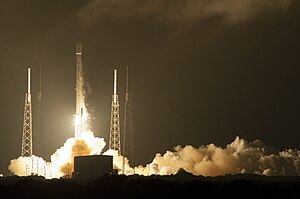 The launch of the Falcon 9 carrying AsiaSat 8. | |
| Mission type | Communications |
|---|---|
| Operator | AsiaSat (2014–2017, 2025–present) Spacecom (2017–2025) |
| COSPAR ID | 2014-046A |
| SATCAT no. | 40107 |
| Website | https://www.asiasat.com https://www.amos-spacecom.com/ |
| Mission duration | Planned: 15 years Elasped: 10 years, 7 months and 2 days |
| Spacecraft properties | |
| Spacecraft | AsiaSat 8 |
| Spacecraft type | SSL 1300 |
| Bus | LS-1300 |
| Manufacturer | Space Systems/Loral |
| Launch mass | 4,535 kg (9,998 lb) |
| Power | 8.5 kW |
| Start of mission | |
| Launch date | 5 August 2014, 08:00 UTC |
| Rocket | Falcon 9 v1.1 |
| Launch site | Cape Canaveral, SLC-40 |
| Contractor | SpaceX |
| Entered service | October 2014 |
| Orbital parameters | |
| Reference system | Geocentric orbit |
| Regime | Geostationary orbit |
| Longitude | 105.5° East (2014–2016) 4° West (2016–2025) |
| Transponders | |
| Band | 25 transponders: 24 Ku-band 1 Ka-band |
| Bandwidth | 54 MHz |
| Coverage area | Asia, Middle East |
AsiaSat 8 then AMOS-7 is a Hong Kong-turned-Israeli geostationary communications satellite which is operated by the Asia Satellite Telecommunications Company (Asiasat).